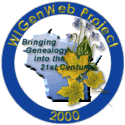|
|
|
|
Finnish Ideologies of Socialism and Communism in the early 20th Century
Politics and religion had always been
important to the Finns for it shaped and controlled their lives. It’s
no surprise then that it was also an important part of their new life in the
small Finnish communities of Brantwood, Clifford and Finns were socialistic by nature, that is ~
they were accustomed to working together for the benefit of their
communities. The socialist ideology of the early 20th century
spurred an effort to improve the condition of the working class and the poor
farmers. As the Lutheran church in
In February 1907 a local branch of the
Social Democratic Party was organized in Brantwood with six members and in
May a Finnish branch was organized with fourteen members. The Party’s
primary focus was improving working conditions and protecting worker’s
rights so people could earn a better living. By June, the erection of a large hall
had begun just a little south of town. The Prentice
The newspaper boasted the success of the
July 4th picnic as follows: “The greatest number of Socialists
ever gathered together in Price county at one time attended the picnic here
on the Fourth. Altho the day was somewhat rainy, over two hundred persons
turned out and made the day a success. The program lasted for six hours and
was good throughout. An unusual sight was the grand parade, one hundred
strong, who made the three-mile march
in good order, singing all the way, with two large red flags and the
stars and stripes heading the procession. Over $30 was cleared.” In 1941, John I. Kolehmainen and George W.
Hill interviewed many Brantwood Finns while doing research for their book, A
Haven in the Woods The Story of the Finns in Wisconsin (Arno Press,
1979). Although they wrote about
several Finnish communities in Even before the Great Depression slammed
into The movement began as early as 1905 when
socialist organizers poured into the state “proclaiming the gospel of freedom”. “The Religious leaders feared the socialist
ideas and tried to scare Finns away from it with threats of fire and
brimstone. It created a separation within communities as some Finns remained
loyal to the Lutheran church who supported capitalist ideals and activities
while others turned their backs to it. In some communities this separation
led Finnish immigrants to be separated into “churched Finns” and
“un-churched Finns”. The ‘un-churched’ Finns
organized and built the socialist halls of Brantwood and Clifford. In 1908, an article published in the
Prentice “People
have Socialism and Communism mixed. Communism stands for the ownership of all
things by all the people; all things to be produced in common and used in
common. Socialism stands for public ownership of public property, that is,
all things the people depend on, which is the machinery of production and
distribution, and private ownership of private property, which is anything
used privately. If the government owned the trusts, with pure democratic
control, we would have social democracy which is socialism.” As the socialist movement grew within the
Finnish communities across the nation, the Finns built one of the largest
labor movements in the world.
The Socialist movement spread to every
Finnish community in the state however, the Brantwood-Clifford community
seemed to be one of the strongest for several years. In 1912 and 1914, the
Socialist Party won every town office position. The Finnish Socialists enjoyed entertaining
activities as much as political ones. Their political meetings frequently
included Finnish songs, recitations, games and dancing along with dramatic
plays that fascinated community members and drew much community support. The Finns involved in these activities were
deeply focused on preserving their Finnish culture and language to the extent
that they were often criticized for their lack of focus on the class
struggle. These Finns became known as “Hall Socialists” or the
“Hall Finns”. All across the In 1920 and 1921, twelve of the As the communist movement heated up, many
Finns realized even more that they were less interested in the proletarian
movement and more interested in nurturing their communities with cultural and
social endeavors while maintaining their own language. When they realized the Communist Party
would take over their businesses, halls and newspapers and absorb them into a
greater movement they realized the blatant violation of their social
democratic procedures and hesitated. This hesitation allowed many Finns to reconsider what it was they really wanted for themselves and their families and caused them to change their minds about joining the Communist Party and signing membership cards. However, several Finns remained committed to the Communist party well into the 21st century.
To learn more about the Socialist and Communist movements as well as the Emigration of Finns to Karelia, click on the titles of the following articles.
Return to Cities, Communities & Villages If you have any
information you would like to contribute, please contact the County Coordinator. |
You are our 1653visitor
.
last edited
24 Apr 2011
|
Copyright Notice: All
files on this site are copyrighted by their creator. They may be linked to
but may not be reproduced on another site without specific permission from |




